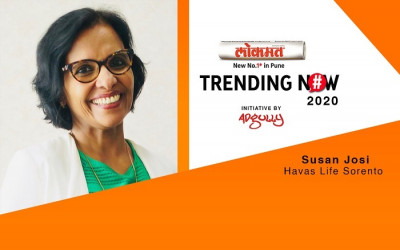Trending Now: Existing privacy laws in India can’t cope with scale of data creation
Susan Josi, Managing Partner, Havas Life Sorento, is optimistic about the scope of digital health in India, even as she sees encouraging growth in digitally influenced retail spending in the year ahead.
What were the few big changes that you think were of importance in 2019 for our industry?
The year 2019 started with a bang with the news that e-health clocked 40 per cent more funds in the previous year with $204 million in 51 deals, of which 48 were domestic companies. Also, India witnessed its first digital health guidelines which could create a pathway for more digital interventions.
Healthcare companies are gearing up in their own way to initiate their internal digital transformation and expanding their consumer connect beyond traditional ways of reaching them.
What are the big changes that you are expecting in 2020?
As the scope of digital health has expanded over time to include online health information, e-commerce, mhealth, wearables, apps, tracking devices for monitoring fitness regimen and specific health conditions, concepts like Artificial Intelligence and Internet of Things are also gaining prominence. And so, while the technology matrix gets bigger and better, consumers are being exposed to digitisation in innovative ways. This again compels the industry to have a much more integrated way of managing their consumers’ health needs and not just stay with their product offering.
How has consumer behaviour changed with the introduction of tech-based marketing?
Undoubtedly, millennials are the prime consumers in the digital world. Mobile phones have increased the consumption of information as well as led to impulse purchases. Convenience has taken centre stage and thus, both online as well as offline mediums have developed their own trail in the distribution footprint. “Digitally influenced retail spending” currently stands at 20 per cent of total retail spending and is likely to touch 30-35 per cent in 2025, as per a recent BCG research. Information-based shopping (with at least 2 data points) was found among 85 per cent of the respondents across categories. In the context of healthcare, it was found that 57 per cent of consumers embrace health and wellness through services, food and gadgets.
But the definition of the digital consumer in India is going beyond the norms – urban, new age, upper socio-economic status – to become more inclusive. The use of audio/ video messages and technology platforms are facilitating a change in behaviour among rural consumers, especially in terms of key issues such as family planning and nutrition, as demonstrated by USAID-funded project – Samvad. The government initiative, “Digital Village”, will also provide health services to consumers in over 700 villages in the first three years through low cost Wi-Fi connectivity. Hence, consumer touchpoints and media experiences will have to re-looked at as the digital medium becomes all-pervasive.
Are we expected to see some big shifts around data regulation in India?
Existing privacy laws in India are simply not designed to deal with the scale of data creation and sharing being proposed. Under Section 43A of the Information Technology Act, 2000 (“IT Act”) and the Information Technology (Reasonable Security Practices and Procedures and Sensitive Personal Data or Information) Rules, 2011 framed under the IT Act, which govern data protection in India, the fundamental requirement is for body corporates to have suitable security measures in place. A failure to safeguard data for the lack of such measures will require a body corporate to award compensation to the individual affected. As a data protection ‘law’, this is hardly adequate.
Two significant steps forward have thus been the release of the draft Digital Information Security in Healthcare Act (“DISHA”)[2] in March, 2018, and the draft of the Personal Data Protection Bill, 2018 (“PDP Bill”)[3], in July, 2018. While both take a consent-based approach to data protection and create a trust-based relationship between an individual and the entity taking his data, there is a stark difference in the position of an individual under each. DISHA imposes significant restrictions on the use of health data and places an individual squarely in control of his data, while the PDP Bill takes a more relaxed approach.
While these are still in the draft stage, one can expect them to be implemented with the necessary changes in 2020.


















Share
Facebook
YouTube
Tweet
Twitter
LinkedIn